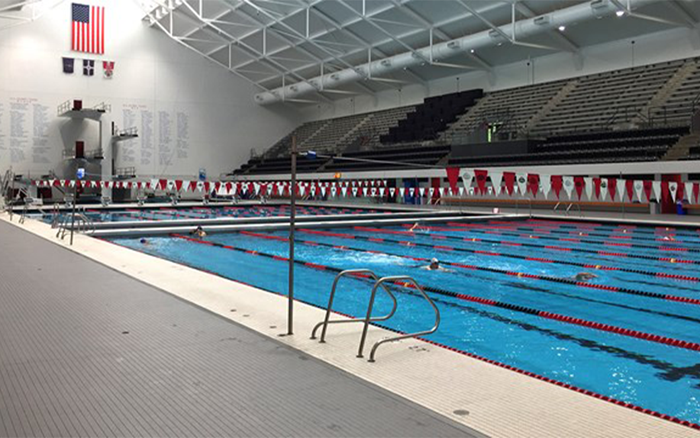What Makes a Swimming Pool Fast?
July 28, 2021 at 11:30 AM

The term “fast pool” is used often in the world of competitive swimming. While many components of a pool make it fast, a swimming pool is considered “fast” when swimmers perform well in it. These components are something a builder focuses on when designing a competitive swimming pool for an aquatic center. A “fast” reputation pays off for the aquatic facility as it becomes a draw to hold swimming races and competitions.
The Design Elements of a Fast Swimming Pool
Here, we look at the five leading design elements that make a difference when creating a fast swimming pool. Let’s dive in!
1. Water Depth
The depth of a competition swimming pool may be the most significant factor in making it fast. Generally speaking, deeper water is faster for competitive swimming, but it cannot be too deep. Shallow water causes waves to bounce or reflect off the bottom of the pool, causing turbulence. Having a wavy pool makes it more difficult for swimmers to move through the water with speed, whereas deeper pools act as a quelling force, making the waves smaller and easier to swim through.
The international governing body for swimming, FINA, requires that an Olympic swimming pool has a minimum depth of two meters (around six and a half feet) throughout the entire length of the pool. However, the recent Olympic standard is typically three meters deep.
2. Gutter Design

(Image Source)
The gutter design plays a significant role in creating a fast competition pool by reducing the waves that are created.
Not only do waves bounce off the bottom of the pool, but they also bounce off the sides of the pool. While there are different gutter types, a perimeter overflow gutter helps eliminate the bounce-back of a wave since surface waves overflow into the gutter, keeping the water at the same level.
The size of the gutter is critical, too, as smaller, shallow gutters will not fully absorb a wave, causing the outside lanes of a swimming pool to become turbulent. The Indiana University Natatorium is considered one of the world’s fastest pools and has a gutter depth of nearly two feet, guaranteeing any and all waves are absorbed.
3. Water Temperature
The temperature of the pool’s water is vital in whether or not it is a fast swimming pool. If the pool is too hot, the swimmer will sweat too much while swimming and possibly overheat. If the water is too cold, a swimmer’s body will go into shock, and their muscles will essentially “freeze” or contract to the point that they are less effective.
The perfect swimming competition pool water temperature is between 77 to 80 degrees Fahrenheit (or 25 to 26.7 degrees Celsius).
The best competition pools have a separate warm-up pool for swimmers, giving them space to warm up and warm down before and after a race. Warm-up pools are usually 80 to 82 degrees Fahrenheit (26.7 to 28 degrees Celsius) so that swimmers can relax and prepare their muscles for their race.
4. Lane Width

Image Source: Getty Images / Tom Pennington
The width of the lanes in a competition swimming pool is imperative to a swimmer’s success and comfort. They need to feel they have enough room to perform the various swimming strokes. Having a wider lane gives the displaced water room so that the swimmer isn’t contending with splashing. It also helps distance each swimmer apart so they aren’t benefiting from another swimmer’s draft nor getting caught in their “wake” which would cause them to slow down.
The requirement for standard pool lanes is seven feet wide; however, most collegiate competition swimming pools typically have a lane width of over 9 feet. The Olympic standard is to have ten lanes 2.5-meters wide.
The best competition pools include buffer lanes at either end as well. These buffers are designed to prevent swimmers from scraping against the pool walls and contending with the push back off the wall, which could potentially put them at a disadvantage during the race. Buffer lanes are not full lanes and usually measure out to be 9 to 18 inches wide.
5. Starting Blocks

Image Source: S.R.Smith
Starting blocks set the tone for the entire race. Swimmers can’t afford unstable or slippery starting blocks that could prevent them from a powerful start to their race. The foundation of a starting block must be solid, whether it’s in the ground or a bulkhead, so the start doesn’t wiggle and cause the swimmer to use unnecessary force and energy.
In 2010, FINA adopted a wedge that can be adjusted atop a starting block, which many major brands have adapted for their starting blocks. The wedge helps with the stability of a start as it could vary \for different swimmers. The grip of the start is also essential to prevent swimmers from slipping off of it; however, most manufacturers do an excellent job with anti-slip surfaces on these starting blocks. The bottom line is that having a stable, well-gripped starting block is essential for having a fast swimming pool.
Swim For Yourself
A swimming pool’s depth, gutter design, temperature, lane width and starting blocks all play a role in creating a fast competitive swimming pool. The next time you’re swimming laps, think, “do I feel fast?” Then check and see if the pool you’re in checks all these boxes.